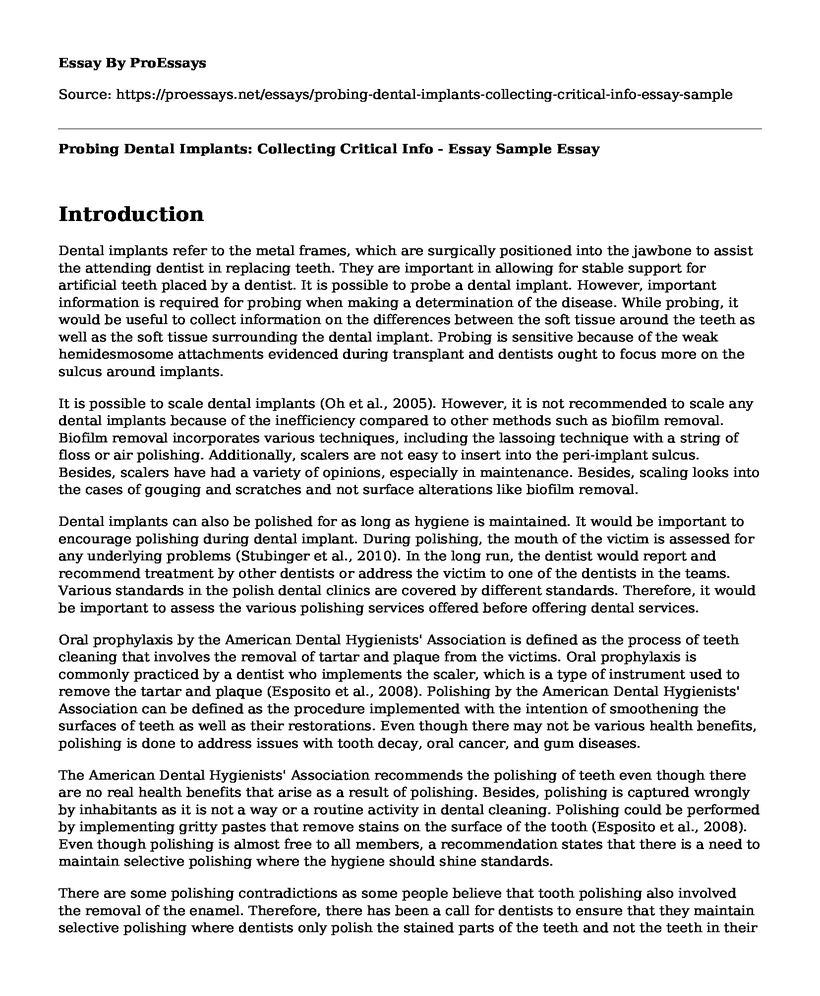Introduction
Dental implants refer to the metal frames, which are surgically positioned into the jawbone to assist the attending dentist in replacing teeth. They are important in allowing for stable support for artificial teeth placed by a dentist. It is possible to probe a dental implant. However, important information is required for probing when making a determination of the disease. While probing, it would be useful to collect information on the differences between the soft tissue around the teeth as well as the soft tissue surrounding the dental implant. Probing is sensitive because of the weak hemidesmosome attachments evidenced during transplant and dentists ought to focus more on the sulcus around implants.
It is possible to scale dental implants (Oh et al., 2005). However, it is not recommended to scale any dental implants because of the inefficiency compared to other methods such as biofilm removal. Biofilm removal incorporates various techniques, including the lassoing technique with a string of floss or air polishing. Additionally, scalers are not easy to insert into the peri-implant sulcus. Besides, scalers have had a variety of opinions, especially in maintenance. Besides, scaling looks into the cases of gouging and scratches and not surface alterations like biofilm removal.
Dental implants can also be polished for as long as hygiene is maintained. It would be important to encourage polishing during dental implant. During polishing, the mouth of the victim is assessed for any underlying problems (Stubinger et al., 2010). In the long run, the dentist would report and recommend treatment by other dentists or address the victim to one of the dentists in the teams. Various standards in the polish dental clinics are covered by different standards. Therefore, it would be important to assess the various polishing services offered before offering dental services.
Oral prophylaxis by the American Dental Hygienists' Association is defined as the process of teeth cleaning that involves the removal of tartar and plaque from the victims. Oral prophylaxis is commonly practiced by a dentist who implements the scaler, which is a type of instrument used to remove the tartar and plaque (Esposito et al., 2008). Polishing by the American Dental Hygienists' Association can be defined as the procedure implemented with the intention of smoothening the surfaces of teeth as well as their restorations. Even though there may not be various health benefits, polishing is done to address issues with tooth decay, oral cancer, and gum diseases.
The American Dental Hygienists' Association recommends the polishing of teeth even though there are no real health benefits that arise as a result of polishing. Besides, polishing is captured wrongly by inhabitants as it is not a way or a routine activity in dental cleaning. Polishing could be performed by implementing gritty pastes that remove stains on the surface of the tooth (Esposito et al., 2008). Even though polishing is almost free to all members, a recommendation states that there is a need to maintain selective polishing where the hygiene should shine standards.
There are some polishing contradictions as some people believe that tooth polishing also involved the removal of the enamel. Therefore, there has been a call for dentists to ensure that they maintain selective polishing where dentists only polish the stained parts of the teeth and not the teeth in their entirety. Some dentists term polishing as not a significant risk. The diverse opinions have created controversy on the need for teeth polishing. The outcome has commonly remained that dentists interested in polishing but concerned about enamel damage could request a finer-grained paste that did not harm them.
References
Esposito, M., Cannizzaro, G., Bozzoli, P., Consolo, U., Felice, P., Ferri, V., ... & Pellitteri, G. (2008). Efficacy of prophylactic antibiotics for dental implants: a multicentre placebo-controlled. Eur J. Oral Implantol, 1(1), 23-31.
Oh, S. H., Finones, R. R., Daraio, C., Chen, L. H., & Jin, S. (2005). Growth of nano-scale hydroxyapatite using chemically treated titanium oxide nanotubes. Biomaterials, 26(24), 4938-4943.
Stubinger, S., Etter, C., Miskiewicz, M., Homann, F., Saldamli, B., Wieland, M., & Sader, R. (2010). Surface alterations of polished and sandblasted and acid-etched titanium implants after Er: YAG, carbon dioxide, and diode laser irradiation. The International Journal of Oral & maxillofacial implants, 25(1), 104.
Cite this page
Probing Dental Implants: Collecting Critical Info - Essay Sample. (2023, May 18). Retrieved from https://proessays.net/essays/probing-dental-implants-collecting-critical-info-essay-sample
If you are the original author of this essay and no longer wish to have it published on the ProEssays website, please click below to request its removal:
- Health Programs Towards Preventing Low Birth Weights. Essay Example on Public Health.
- The Process of Nurturing the Infants: Creating Space for the Baby Essay
- Comparative Studies of Ebola, Influenza, HIV and Zika Viruses Paper Example
- Evidence-Based Practice in the Workplace Paper Example
- HIV/AIDS Agenda Paper Example
- Oncology Nurses: Providing Physical & Psychological Care for Cancer Patients - Essay Sample
- Radiographers & Operators: Applying 3 Principles to Ensure Safety - Essay Sample







